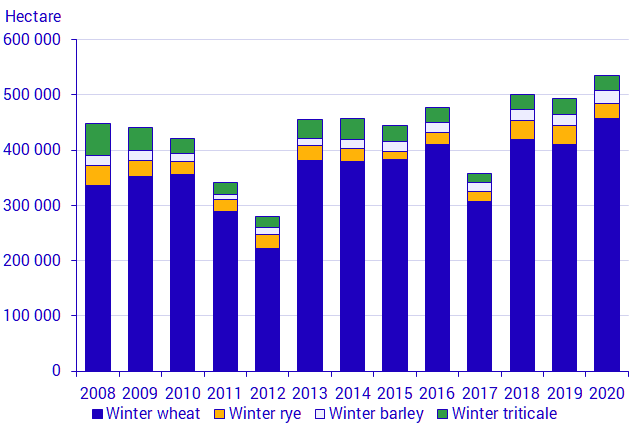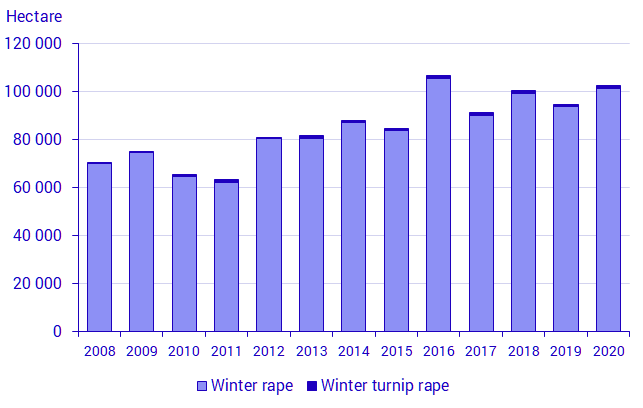Autumn sown areas 2020:
Largest winter wheat acreage ever
Statistical news from Statistics Sweden and Swedish Board of Agriculture 2020-11-30 9.30
This year’s autumn sowing of cereals and oilseed crops amounted to 638 300 hectares, which is 8 percent more than last autumn’s acreage and 16 percent more than the last five-year average. This increase is mainly due to a record winter wheat acreage. Just below 72 percent of the total autumn sown acreage this year was winter wheat.
The majority of this year’s crops could be harvested early, and the autumn was warmer than normal. This gave many farmers an opportunity to prepare the land for autumn sowing, which they did to a large extent.
Large autumn sown areas are beneficial for many reasons, not least because they help reduce nutrition losses from arable land.
Largest increase in Västra Götaland County and Västmanland County
In Sweden, 457 900 hectares of winter wheat were sown in total this autumn, which is 12 percent more than last autumn and is the largest acreage ever. This year’s winter wheat area is 19 percent larger than last five-year autumn average and 29 percent more than the ten-year average.
The areas of winter wheat increased considerably mainly in Västra Götaland County and Västmanland County, where the areas were 23 percent and 42 percent respectively more than the corresponding area last autumn. In most of the remaining counties, the winter wheat areas were on a level with last year’s large areas.
Winter rye and winter triticale areas on a level with five-year average
The autumn sown areas of rye amounted to 27 000 hectares, which is 20 percent less than last autumn, but on a level with the five-year average. Winter barley areas are estimated at 23 200 hectares, which is on a level with last autumn, but exceeds the five-year average by 22 percent. The autumn sown areas of triticale are estimated at 27 800 hectares, which is on a level with both the five-year average and last autumn.
Winter rape areas verges on last year’s level
Winter rape areas were estimated at 101 100 hectares. This means it is about the same size as last autumn’s area, but 7 percent more than the five-year average. Winter turnip areas were estimated at 1 300 hectares.
Organically cultivated autumn sowing larger than the five-year average
Total autumn sown areas cultivated organically amounted to 52 600 hectares, which is on a level with last autumn’s area, but 31 percent more than the five-year average. There were 34 400 hectares of organically cultivated winter wheat, which verges on last year’s areas, and corresponds to 35 percent more than the five-year average. Organically cultivated winter rape areas were estimated at 7 900 hectares, which is 30 percent more than last autumn’s areas.
Early harvest facilitated large autumn sown areas – hampered by wildlife damage
Like last year, there was relatively ample time this year to prepare the land for autumn sowing, since it was possible to harvest this year’s crops early in southern and central Sweden. However, some farmers reported that they did not sow autumn sown wheat and oilseed crops because they expected wild boar, deer, and geese to destroy the crops.


Note that the figures for cereals and oilseed crops use different scales.
Publication
A more detailed report of this survey and results by county and production area is published in the Statistical Report JO 18 SM 2001 and on the Swedish Board of Agriculture website. The statistics on autumn sown areas are also available in the Swedish Board of Agriculture´s statistical database.
The information is based on a survey where nearly 5 000 farmers submitted information to Statistics Sweden about autumn sown areas.
Feel free to use the facts from this statistical news but remember to state Source: Statistics Sweden.
